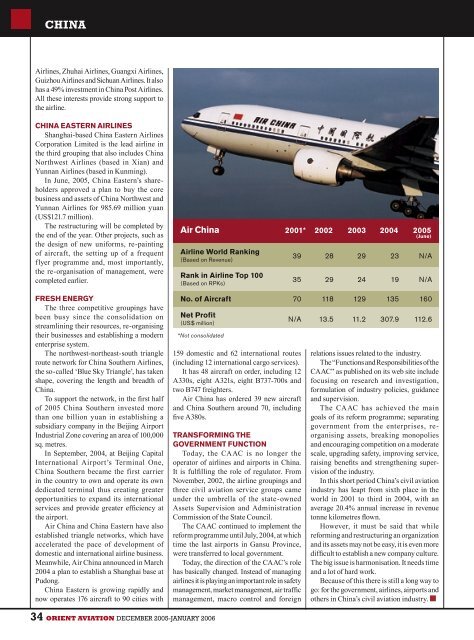You also want an ePaper? Increase the reach of your titles
YUMPU automatically turns print PDFs into web optimized ePapers that Google loves.
CHINA<br />
Airlines, Zhuhai Airlines, Guangxi Airlines,<br />
Guizhou Airlines and Sichuan Airlines. It also<br />
has a 49% investment in China Post Airlines.<br />
All these interests provide strong support to<br />
the airline.<br />
CHINA EASTERN AIRLINES<br />
Shanghai-based China Eastern Airlines<br />
Corporation Limited is the lead airline in<br />
the third grouping that also includes China<br />
Northwest Airlines (based in Xian) and<br />
Yunnan Airlines (based in Kunming).<br />
In June, 2005, China Eastern’s shareholders<br />
approved a plan to buy the core<br />
business and assets of China Northwest and<br />
Yunnan Airlines for 985.69 million yuan<br />
(US$121.7 million).<br />
The restructuring will be completed by<br />
the end of the year. Other projects, such as<br />
the design of new uniforms, re-painting<br />
of aircraft, the setting up of a frequent<br />
flyer programme and, most importantly,<br />
the re-organisation of management, were<br />
completed earlier.<br />
Air China<br />
Airline World Ranking<br />
(Based on Revenue)<br />
Rank in Airline Top 100<br />
(Based on RPKs)<br />
2001 * 2002 2003 2004 2005<br />
(June)<br />
39 28 29 23 N/A<br />
35 29 24 19 N/A<br />
FRESH ENERGY<br />
The three competitive groupings have<br />
been busy since the consolidation on<br />
streamlining their resources, re-organising<br />
their businesses and establishing a modern<br />
enterprise system.<br />
The northwest-northeast-south triangle<br />
route network for China Southern Airlines,<br />
the so-called ‘Blue Sky Triangle’, has taken<br />
shape, covering the length and breadth of<br />
China.<br />
To support the network, in the first half<br />
of 2005 China Southern invested more<br />
than one billion yuan in establishing a<br />
subsidiary company in the Beijing Airport<br />
Industrial Zone covering an area of 100,000<br />
sq. metres.<br />
In September, 2004, at Beijing Capital<br />
International Airport’s Terminal One,<br />
China Southern became the first carrier<br />
in the country to own and operate its own<br />
dedicated terminal thus creating greater<br />
opportunities to expand its international<br />
services and provide greater efficiency at<br />
the airport.<br />
Air China and China Eastern have also<br />
established triangle networks, which have<br />
accelerated the pace of development of<br />
domestic and international airline business.<br />
Meanwhile, Air China announced in March<br />
2004 a plan to establish a Shanghai base at<br />
Pudong.<br />
China Eastern is growing rapidly and<br />
now operates 176 aircraft to 90 cities with<br />
No. of Aircraft 70 118 129 135 160<br />
Net Profit<br />
(US$ million)<br />
*Not consolidated<br />
159 domestic and 62 international routes<br />
(including 12 international cargo services).<br />
It has 48 aircraft on order, including 12<br />
A330s, eight A321s, eight B737-700s and<br />
two B747 freighters.<br />
Air China has ordered 39 new aircraft<br />
and China Southern around 70, including<br />
five A380s.<br />
TRANSFORMING THE<br />
GOVERNMENT FUNCTION<br />
Today, the CAAC is no longer the<br />
operator of airlines and airports in China.<br />
It is fulfilling the role of regulator. From<br />
November, 2002, the airline groupings and<br />
three civil aviation service groups came<br />
under the umbrella of the state-owned<br />
Assets Supervision and Administration<br />
Commission of the State Council.<br />
The CAAC continued to implement the<br />
reform programme until July, 2004, at which<br />
time the last airports in Gansu Province,<br />
were transferred to local government.<br />
Today, the direction of the CAAC’s role<br />
has basically changed. Instead of managing<br />
airlines it is playing an important role in safety<br />
management, market management, air traffic<br />
management, macro control and foreign<br />
N/A 13.5 11.2 307.9 112.6<br />
relations issues related to the industry.<br />
The “Functions and Responsibilities of the<br />
CAAC” as published on its web site include<br />
focusing on research and investigation,<br />
formulation of industry policies, guidance<br />
and supervision.<br />
The CAAC has achieved the main<br />
goals of its reform programme; separating<br />
government from the enterprises, reorganising<br />
assets, breaking monopolies<br />
and encouraging competition on a moderate<br />
scale, upgrading safety, improving service,<br />
raising benefits and strengthening supervision<br />
of the industry.<br />
In this short period China’s civil aviation<br />
industry has leapt from sixth place in the<br />
world in 2001 to third in 2004, with an<br />
average 20.4% annual increase in revenue<br />
tonne kilometres flown.<br />
However, it must be said that while<br />
reforming and restructuring an organization<br />
and its assets may not be easy, it is even more<br />
difficult to establish a new company culture.<br />
The big issue is harmonisation. It needs time<br />
and a lot of hard work.<br />
Because of this there is still a long way to<br />
go: for the government, airlines, airports and<br />
others in China’s civil aviation industry.<br />
34 ORIENT AVIATION DECEMBER 2005-JANUARY 2006








![OAMag-V7N4-Cover [Converted] - Orient Aviation](https://img.yumpu.com/48598575/1/190x255/oamag-v7n4-cover-converted-orient-aviation.jpg?quality=85)








